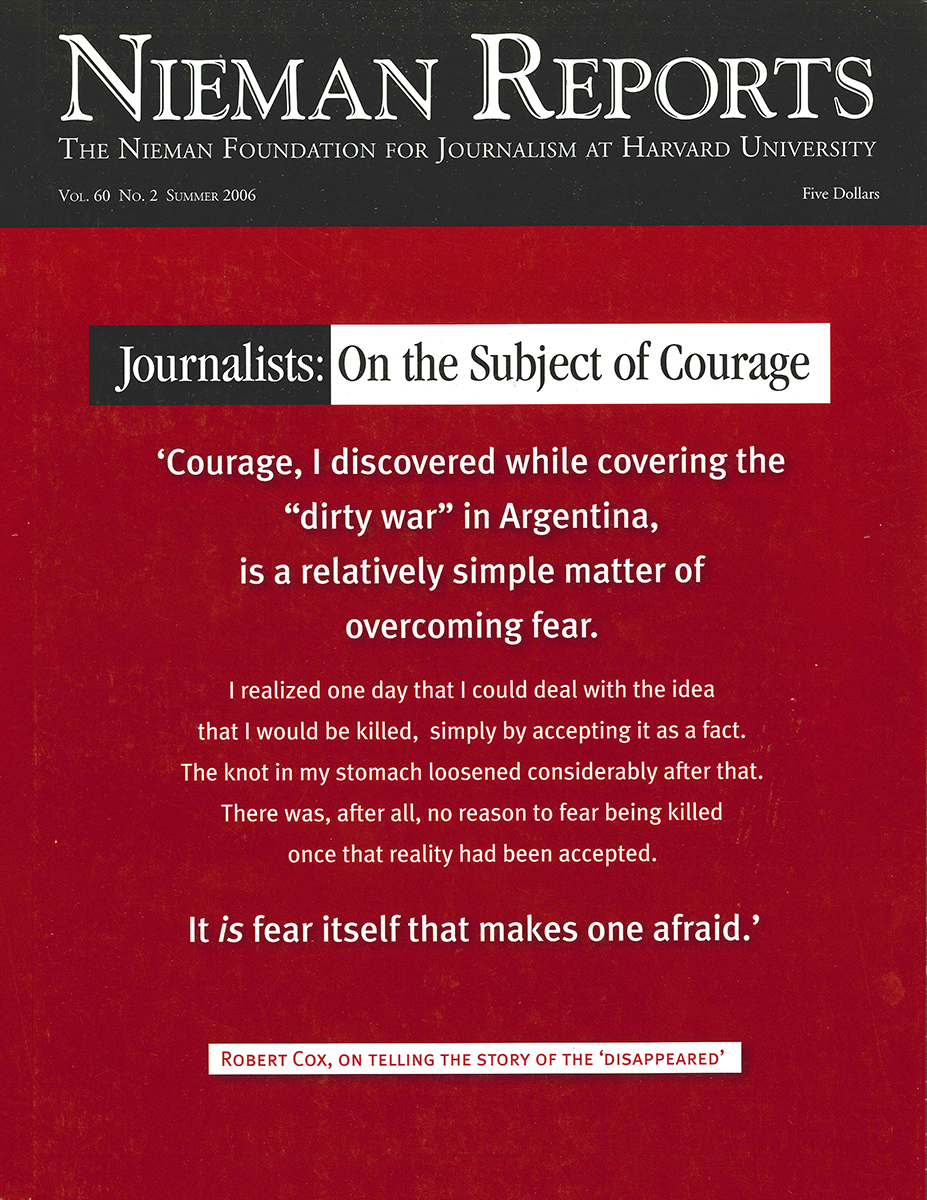When I think about courage in the context of my country, Pakistan, I am reminded of the Cowardly Lion who went looking for the Wizard of Oz so he could get courage and then realized he actually already had it. It strikes me that reporting honestly and fairly — what the best of journalism should be about — requires courage whenever the surrounding climate is geared towards suppressing the truth, as it is in Pakistan and so many other places today.
Despite press freedom in the United States, for example, many journalists still find it hard to question authority, investigate corruption, or follow up on unpalatable truths. Some who report on government and politics in Washington, D.C. have told me about the self-imposed restraints that creep into their work. Other conversations reveal that many U.S. journalists are so afraid of being labeled "partisan" in their coverage that they do what they can to accommodate "the other side." Those who ask questions that are unpalatable to the administration find themselves being edged out of the circle of those privy to inside information or not called on during press conferences. Recently John Green, executive producer of the weekend edition of ABC’s "Good Morning America," was suspended after e-mail messages he wrote that were critical of President Bush and former Secretary of State Madeleine Albright were leaked.
The more I learn about journalism in the United States, the more I believe that things aren’t all that different with journalism in Pakistan. Even today, when the press situation is freer than it’s ever been, what is happening in Washington is familiar to journalists in Pakistan who dare to cross swords with the establishment. There are, of course, more constitutional protections and legal safeguards in the United States; much reporting about government abuses (Guantanamo Bay and Abu Ghraib) is done without reprisal, even at a time of heightened concern about prosecutorial attempts to force journalists to reveal sources. Still, even in this reporting, few reporters have probed beyond the obvious transgressions of human rights: The focus remains on the whistleblowers rather than on those who are violating human rights.
In Pakistan, despite recent improvements in press freedom, dangers remain for those whose reporting takes them against the official version of the truth. There are numerous examples of what happens to these transgressors, well documented by watchdog bodies such as the Committee to Protect Journalists (CPJ), Amnesty International, and Human Rights Watch. Among the tactics of intimidation used are phone taps, surveillance, threatening or interrogating phone calls, or visits from intelligence agency personnel. Since the "war on terror" was declared, in which Pakistan is a key U.S. ally, Pakistan’s intelligence agencies have developed close links to their American counterparts, and this war is used as a handy excuse to intimidate the political opposition, as well as journalists who question official policy.
The cozy relationship between Pakistani and U.S. intelligence agencies means that "terror suspects" can be handed over to American authorities in Pakistan, though this practice is denied by both sides. Journalists fear that this is what happened to Hayatullah Khan, who was kidnapped by "unidentified gunmen" last December. Khan, who worked for the Urdu-language daily, Ausaf, and the European Pressphoto Agency in Pakistan’s tribal areas, is still missing. Colleagues believe his disappearance is linked to a report he filed that contradicted official accounts claiming that a senior al-Qaeda commander, Abu Hamza Rabia, died after munitions exploded inside a house. According to a CPJ report, "Khan quoted local tribesmen as saying the house was hit by an air-launched missile. He photographed fragments of the missile for the European Pressphoto Agency." Using his photos, foreign journalists identified it as a Hellfire missile fired from a U.S. drone. CPJ went on to note that Khan received "numerous threats from Pakistani security forces, Taliban members, and local tribesmen because of his reporting."
Intimidation and danger now also come to journalists from militant organizations that have gained in strength during the past few decades. Drawing strength from ethnic or religious polarization, members of these organizations have attacked reporters and editors, as well as buildings where journalists work. They’ve also gone after those who sell newspapers on the street. Arson and guns are among their weapons of intimidation.
When journalists offer support to colleagues in trouble, danger transfers itself to them in the form of threats, intimidation and harassment. In 1999, journalists were involved in a campaign calling for the release of Najam Sethi, editor of the weekly The Friday Times, whom the government’s intelligence agencies had picked up after he gave a speech in "enemy territory" (New Delhi, India), in which he was allegedly critical of Pakistan. A climate of menace descended on some of these journalists; a note delivered to the home of Ejaz Haider, a colleague at The Friday Times, warned him to install bulletproof windows in his car. Journalists Imtiaz Alam and Amir Mir, who had been writing about the intelligence agencies’ transgressions and also had been involved in the effort to free Sethi, had their cars set on fire outside their homes.
Other colleagues have faced consequences for what they’ve reported or for working with foreign journalists probing issues the government preferred to suppress. There are numerous examples, including several prominent journalists who had to flee the country after their interrogations by the intelligence agencies. Soon after freelance journalist Ghulam Hasnain "disappeared" for 48 hours in January 2002, he left the country with his family and for months he could not talk about his treatment at the hands of Pakistan’s intelligence agencies. Khawar Mehdi Rizvi, now in political asylum in the United States, knows, too, about the tactics of the intelligence agencies: He was a "fixer" who worked with the French journalists whom the Pakistani authorities arrested in December 2003 for being in an area they were not "authorized" to be in. He was held without any charges for more than a month and then charged with sedition for working against the "national interest."
There are some journalists in Pakistan (and throughout the world) who criticize these reporters as being "foolhardy." They argue, perhaps rightly, that they should have obtained "versions" from the other side and presented them alongside the information they did report. Journalists in Pakistan often find it difficult to obtain such "versions," given the secrecy culture of those who are in power. And given "the other side’s" power, if an attempt is made to obtain such information there is a good chance the story will not run either because pressure will be put on the editors not to do so or because the editors themselves might exercise caution through self-censorship.
When journalists see what happens to reporters like Khan and others, it deters some from probing further into situations that should be more deeply investigated. Imtiaz Alam, who started the South Asian Free Media Association in July 2000, observes that the Pakistani news media, while quite vibrant and critical, is "being gradually entrapped in an elaborate system of self-censorship," as corporate interests increasingly set the nature of content and the direction of editorial policy. Given the climate in which they work, journalists are cautious in how they report on the army, the intelligence agencies, corruption and religious extremists.
Journalists who exercise their political right as citizens to peaceful protest also need courage, given the tendency of police to use tear gas and batons. Recently in Islamabad the police attacked and arrested journalists demonstrating to demand changes in the Pakistan Electronic Media Regulatory Authority (PEMRA), a law that gives sweeping powers to law enforcement agencies and to PEMRA.
For a woman in Pakistan, holding a job as a journalist comes with all of the challenges that women reporters everywhere face — trying to balance responsibilities of the home with those of the newsroom while proving themselves on the job in ways male colleagues do not seem to need to do. This can push one into being sterner than one might like. It needs additional courage to do all of this in the traditionally male-dominated atmosphere that exists most noticeably in local language publications. There the newsroom environment is often hostile to the presence of women; Urdu newspapers, for example, persist in using bylines such as "By Our Lady Reporter" despite protests by journalists’ organizations. Women in the local language media are also often underpaid, have little or no job security, and no health coverage. For those of us who work in the English language press the situation is relatively better, given the more progressive atmosphere there. However, with the rise of private television stations and newspapers, the number of women journalists is increasing, even in more conservative small towns throughout the country.
Beena Sarwar, a 2006 Nieman Fellow from Pakistan, will return to the United States as a fellow at the Carr Center for Human Rights Policy at the John F. Kennedy School of Government at Harvard. She is the former op-ed and features editor of The News International, former editor of the News on Sunday, and a documentary filmmaker.


